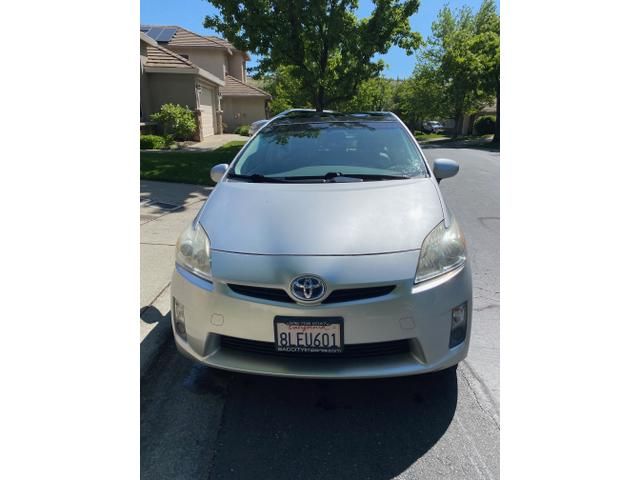
2010 TOYOTA PRIUSVIN: JTDKN3DU7A1013879
Historical Records
Vandalism damage reported
Damage to front
Tire repaired
Collision damage reported
Sale Record
| Year | 2010 |
| ODO | 7900 mi |
| Seller | Hidden text (Hidden text) |
| Location | undefined, undefined, undefined |
| Date | appeared 6 months ago latest price $7136 sale post disappeared 2023-06-22 |
| Sale Website Type | classifieds |
| Notes | |
| Hidden text | |



| Body Style | Hatchback |
| Color | Classic Silver Metallic |
| Color (Interior) | Gray |
| Transmission | CVT |
| Engine | 1.8L I-4 DOHC, VVT-i variable valve control, regular unleaded, e |
| Drive | Front-wheel Drive |
| Fuel Type | Gasoline |
- 6266
- Accessory power Retained accessory power
- Hidden text
- Anti-Theft System - Vehicle Immobilizer
- Hidden text
- Automatic Emergency Braking
- Hidden text
- Beverage holders rear Rear beverage holders
- Hidden text
- Cabin air filter
- Hidden text
- Child door locks Manual rear child safety door locks
- Hidden text
- Cupholders - Rear
- Hidden text
- Door mirror type Standard style side mirrors
- Hidden text
- Drivetrain selectable Driver selectable drivetrain mode
- Hidden text
- Emergency Locking Retractors - Rear
- Hidden text
- Fabric Seat Trim
- Hidden text
- Front Airbags - Dual
- Hidden text
- Front Suspension Classification - Independent
- Hidden text
- Front seatback upholstery Cloth front seatback upholstery
- Hidden text
- Headlights - Auto Delay Off
- Hidden text
- Hybrid Gas Engine HP - 98
- Hidden text
- In-Dash CD - Mp3 Playback
- Hidden text
- Knee airbag Driver side knee airbag
- Hidden text
- Manual passenger seat controls Passenger seat manual reclining and fore/aft ...
- Hidden text
- Number of first-row LCD screens 1 total number of 1st row displays
- Hidden text
- Paint Metallic paint
- Hidden text
- Power Windows
- Hidden text
- Rear Brake Type - Disc
- Hidden text
- Rear Suspension Type - Torsion Beam
- Hidden text
- Rear seat upholstery Cloth rear seat upholstery
- Hidden text
- Roadside warranty 24 month/25,000 miles
- Hidden text
- Service interval warning Service interval indicator
- Hidden text
- Spare tire Compact spare tire with steel wheel
- Hidden text
- Stability Control
- Hidden text
- Steering mounted climate control Steering wheel mounted climate controls
- Hidden text
- Suspension Standard ride suspension
- Hidden text
- Tire Pressure Monitoring System
- Hidden text
- Transmission Electronic Control
- Hidden text
- Visor illuminated driver mirror Illuminated driver visor mirror
- Hidden text
- Window Defogger - Rear
- Hidden text
- Airbag Deactivation - Occupant Sensing Passenger
- Hidden text
- Armrests front center Front seat center armrest
- Hidden text
- Basic warranty 36 month/36,000 miles
- Hidden text
- Brake type 4-wheel disc brakes
- Hidden text
- Cargo light Cargo area light
- Hidden text
- Console insert material Metal-look console insert
- Hidden text
- Digital signal processor JBL Synthesis digital signal processor
- Hidden text
- Drive type Front-wheel drive
- Hidden text
- Electric Motor Torque - 153
- Hidden text
- Engine Cylinders I4
- Hidden text
- Floor coverage Full floor coverage
- Hidden text
- Front Headrests - Adjustable
- Hidden text
- Front head restraint control Manual front seat head restraint control
- Hidden text
- Fuel door Manual fuel door release
- Hidden text
- Headliner material Cloth headliner material
- Hidden text
- Hybrid/electric components warranty 96 month/100000 miles
- Hidden text
- Interior courtesy lights Fade interior courtesy lights
- Hidden text
- Lock-up transmission
- Hidden text
- Multi-Function Remote - Panic Alarm
- Hidden text
- One-touch down window Front and rear one-touch down windows
- Hidden text
- Passenger doors rear right Conventional right rear passenger door
- Hidden text
- Push-button start
- Hidden text
- Rear Shock Type - Gas
- Hidden text
- Rear cargo door Liftgate rear cargo door
- Hidden text
- Rear Window Defroster
- Hidden text
- Seatbelt Pretensioners - Front
- Hidden text
- Side Curtain Airbags - Rear
- Hidden text
- Special paint Monotone paint
- Hidden text
- Steering Wheel - Tilt And Telescopic
- Hidden text
- Steering wheel telescopic Manual telescopic steering wheel
- Hidden text
- Suspension type rear Torsion beam rear suspension
- Hidden text
- Traction Control
- Hidden text
- Upholstery - Cloth
- Hidden text
- Warnings And Reminders - Lamp Failure
- Hidden text
- 1.8L 4-Cylinder DOHC 16V VVT-I Engine
- 7823
- Active Head Restraints - Dual Front
- Hidden text
- Anti-roll bar front Front anti-roll bar
- Hidden text
- Aux input jack Auxiliary input jack
- Hidden text
- Body panels Galvanized steel/aluminum body panels with side impact beams
- Hidden text
- Cargo area light
- Hidden text
- Climate control Automatic climate control
- Hidden text
- Cylinder head material Aluminum cylinder head
- Hidden text
- Door mirrors Power door mirrors
- Hidden text
- Electric Motor Battery Type - Nickel-Metal Hydride
- Hidden text
- Emissions SULEV II emissions
- Hidden text
- First-row windows Power first-row windows
- Hidden text
- Front Brake Diameter - 10.0
- Hidden text
- Front Suspension Type - Lower Control Arms
- Hidden text
- Front side impact airbag driver Seat mounted side impact driver airbag
- Hidden text
- Headlights Halogen headlights
- Hidden text
- Hybrid Gas Engine Hp@Rpm - 5200
- Hidden text
- In-Dash CD - Single Disc
- Hidden text
- LCD primary display size 6.1 inch primary LCD display
- Hidden text
- Mirror Color - Body-Color
- Hidden text
- Occupancy sensor Airbag occupancy sensor
- Hidden text
- Panel insert Metal-look instrument panel insert
- Hidden text
- Powertrain type Hybrid
- Hidden text
- Rear Headrests - 2
- Hidden text
- Rear Trunk/Liftgate - Liftgate
- Hidden text
- Rear seatback upholstery Carpet rear seatback upholstery
- Hidden text
- Satellite Radio - Siriusxm
- Hidden text
- Shock absorbers Gas-pressurized shock absorbers
- Hidden text
- Spare tire location Spare tire mounted under the cargo floor
- Hidden text
- Start-stop engine Auto stop-start engine
- Hidden text
- Steering type Rack-pinion steering
- Hidden text
- Suspension ride type front Independent front suspension
- Hidden text
- Tire Type - All Season
- Hidden text
- Trip Computer
- Hidden text
- Visor illuminated passenger mirror Illuminated passenger visor mirror
- Hidden text
- Window Trim Black side window trim
- Hidden text
- Air Filtration
- Hidden text
- Anti-roll bar rear Rear anti-roll bar
- Hidden text
- Auxiliary Audio Input - Jack
- Hidden text
- Brake Assist
- Hidden text
- Cargo cover Roll-up cargo cover
- Hidden text
- Clock In-dash clock
- Hidden text
- Day/night rearview mirror
- Hidden text
- Door panel insert Metal-look door panel insert
- Hidden text
- Electric Motor HP - 80
- Hidden text
- Emissions tiers Tier 2 Bin 3 emissions
- Hidden text
- Floor console Full floor console
- Hidden text
- Front Brake Type - Ventilated Disc
- Hidden text
- Front Wipers - Variable Intermittent
- Hidden text
- Front side impact airbag passenger Seat mounted side impact front passenger ...
- Hidden text
- HEADLIGHTS ON REMINDER
- Hidden text
- Hybrid Gas Engine Torque - 105
- Hidden text
- Instrumentation display Digital instrumentation display
- Hidden text
- LED brake lights
- Hidden text
- Multi-function display
- Hidden text
- Oil pressure warning
- Hidden text
- Passenger Seat Manual Adjustments - 4
- Hidden text
- Powertrain warranty 60 month/60,000 miles
- Hidden text
- Rear Seat Type - 60-40 Split Bench
- Hidden text
- Rear Wiper - Variable Intermittent
- Hidden text
- Rear seats fixed or removable Fixed rear seats
- Hidden text
- Seatback storage pockets 2 seatback storage pockets
- Hidden text
- Side Airbags - Front
- Hidden text
- Speakers JBL speakers
- Hidden text
- Starter Hybrid electric motor starter
- Hidden text
- Steering type number of wheels 2-wheel steering system
- Hidden text
- Suspension ride type rear Semi-independent rear suspension
- Hidden text
- Tires P195/65SR15 AS BSW front and rear tires
- Hidden text
- Trip odometer
- Hidden text
- Visor passenger mirror Passenger visor mirror
- Hidden text
- Wipers Variable intermittent front windshield wipers
- Hidden text
- Air conditioning Yes
- Hidden text
- Armrests - Rear Folding
- Hidden text
- Backup camera
- Hidden text
- Brake assist system
- Hidden text
- Cargo floor type Carpet cargo area floor
- Hidden text
- Concealed cargo storage Cargo area concealed storage
- Hidden text
- Delay off headlights Delay-off headlights
- Hidden text
- Door trim insert Cloth door trim insert
- Hidden text
- Electric Motor Power Output (Kilowatts) - 60
- Hidden text
- Engine 1.8L I-4 DOHC, VVT-i variable valve control, regular unleaded, engine...
- Hidden text
- Floor console storage Covered floor console storage
- Hidden text
- Front Headrests - 2
- Hidden text
- Front anti-whiplash head restraints Anti-whiplash front seat head restraints...
- Hidden text
- Fuel Type Regular Unleaded
- Hidden text
- Headliner coverage Full headliner coverage
- Hidden text
- Hybrid Gas Engine Torque@Rpm - 4000
- Hidden text
- Interior accents Metal-look interior accents
- Hidden text
- License plate front bracket Front license plate bracket
- Hidden text
- Multi-Function Remote - Keyless Entry
- Hidden text
- One-Touch Windows - 4
- Hidden text
- Passenger doors rear left Conventional left rear passenger door
- Hidden text
- Premium Brand - Jbl
- Hidden text
- Rear Seatbelts - 3-Point
- Hidden text
- Rear Wiper - With Washer
- Hidden text
- Rear under seat ducts Rear under seat climate control ducts
- Hidden text
- Seatbelt Force Limiters - Front
- Hidden text
- Side Curtain Airbags - Front
- Hidden text
- Speakers number 8 speakers
- Hidden text
- Steering Electric power-assist steering system
- Hidden text
- Steering wheel material Urethane steering wheel
- Hidden text
- Suspension type front Strut front suspension
- Hidden text
- Total Speakers - 8
- Hidden text
- Trunk lid trim Plastic trunk lid trim
- Hidden text
- Warnings And Reminders - Coolant Temperature Warning
- Hidden text
- Wireless Data Link - Bluetooth
Model Analytics & Market Report
Depreciation
| Year | Average Mileage | Average Price | % Left | % Lost | ||
|---|---|---|---|---|---|---|
| 2010 MSRP | 0 mi | $26,860 | — | — | 100% | 0% |
| 2010 | 11,146 mi | $36,998 | −$10,138 | −37.74% | 137.74% | -37.74% |
| 2011 | 22,292 mi | $32,719 | +$4,279 | +11.57% | 121.81% | -21.81% |
| 2012 | 33,438 mi | $24,998 | +$7,721 | +23.6% | 93.07% | 6.93% |
| 2013 | 44,584 mi | $25,500 | −$502 | −2.01% | 94.94% | 5.06% |
| 2014 | 55,730 mi | $24,977 | +$523 | +2.05% | 92.99% | 7.01% |
| → Visit 2010 TOYOTA PRIUS depreciation page to see full data. | ||||||
Price vs Mileage
| Mileage | Average Price | Sample Size |
|---|---|---|
| 30,000 mi | $14,993 | 10 sales |
| 35,000 mi | $14,999 | 11 sales |
| 40,000 mi | $13,044 | 16 sales |
| 45,000 mi | $12,990 | 31 sales |
| 50,000 mi | $13,015 | 30 sales |
| 55,000 mi | $12,700 | 47 sales |
| → Visit 2010 TOYOTA PRIUS depreciation page to see full data. | ||
VIN Decoder — 33 records
A TPMS is an electronic system designed to monitor the air pressure inside the pneumatic tires on various types of vehicles. TPMS can be divided into two different types - direct and indirect. Direct TPMS employ pressure sensors on each wheel, either internal or external. The sensors physically measure the tire pressure in each tire and report it to the vehicle's instrument cluster or a corresponding monitor. Indirect TPMS does not use physical pressure sensors but measure air pressures by monitoring individual wheel rotational speeds and other signals available outside of the tire itself.
Engine displacement (in cubic centimeters) is the volume swept by all the pistons inside the cylinders of a reciprocating engine in a single movement from top dead center to bottom dead center.
Engine displacement (in cubic inches) is the volume swept by all the pistons inside the cylinders of a reciprocating engine in a single movement from top dead center to bottom dead center.
Engine displacement (in liters) is the volume swept by all the pistons inside the cylinders of a reciprocating engine in a single movement from top dead center to bottom dead center.
Electrification level defines to what level the vehicle is powered by electric system. The common electric system configurations are mild hybrid, strong hybrid, plug-in hybrid, battery electric, and fuel cell vehicles.
(1) Mild hybrid is the system such as 12-volt start-stop or 48-volt belt integrator starter generator (BISG) system that uses an electric motor to add assisting power to the internal combustion engine. The system has features such as stop-start, power assist, and mild level of generative braking features.
(2) Strong hybrid systems, in vehicles such as the Toyota Prius, mainly consist of motors, conventional gasoline engine, and battery, but the source of electrical charge for the battery power is provided by the conventional engine and/or regenerative braking.
(3) Plug-in hybrid systems, in vehicles such as the Toyota Rav4 Prime, mainly consist of motors, conventional gasoline engine and battery. Plug-in hybrid vehicles are like strong hybrids, but they have a larger battery pack and can be charged with an external source of electricity by electric vehicle supply equipment (EVSE).
(4) Battery electric vehicles (BEV), such as the Tesla Model S or Nissan Leaf, have only a battery and electrical motor components and use electricity as the only power source.
(5) Fuel cell electric vehicles (FCEV) use full electric drive platforms but consume electricity generated by onboard fuel cells and hydrogen fuel.
Engine configuration defines how engine cylinders are arranged. Common values are V6 for V-shaped arrangement, I4 or L4 for in-line arrangement.
This is a numerical field to store the number of cylinders in an engine. Common values for passenger cars are 4 or 6.
Body Class presents the body type based on 49 CFR 565.12(b): "Body type means the general configuration or shape of a vehicle distinguished by such characteristics as the number of doors or windows, cargo-carrying features and the roofline (e.g., sedan, fastback, hatchback)." Definitions are not provided for individual body types in the regulation.
Gross vehicle weight rating (GVWR) is the maximum operating weight of a vehicle including the vehicle's chassis, body, engine, engine fluids, fuel, accessories, driver, passengers and cargo, but excluding that of the trailers. Per 49 CFR 565.15, Class 1 is further broken down to Class A-D; Class 2 is further broken down to Class E-H. This field captures the lower bound of GVWR range for the vehicle.
Gross vehicle weight rating (GVWR) is the maximum operating weight of a vehicle including the vehicle's chassis, body, engine, engine fluids, fuel, accessories, driver, passengers and cargo, but excluding that of the trailers. Per 49 CFR 565.15, Class 1 is further broken down to Class A-D; Class 2 is further broken down to Class E-H. This field captures the higher bound of GVWR range for the vehicle.
Per 49 CFR 565, Model means a name that a manufacturer applies to a family of vehicles of the same type, make, line, series and body type.
If the model year (MY) is supplied when the VIN is decoded, such as from a crash report or a vehicle registration record, the MY value will be the supplied MY, even if the MY decoded from the VIN differs from the supplied MY. If the MY is not supplied when the VIN is decoded, the MY value will be decoded from the 10th character in the VIN.
This data element captures the city of the manufacturing plant where the manufacturer affixes the VIN.
This data element captures the name of the company that owns the manufacturing plant where the manufacturer affixes the VIN.
This data element captures the country of the manufacturing plant where the manufacturer affixes the VIN.
This data element captures the State or Province name within the Plant Country of the manufacturing plant where the manufacturer affixes the VIN.
This field captures the location of curtain air bags. Curtain air bags are side air bags that protect the head.
This field captures the location of frontal air bags. Frontal air bags are generally designed to deploy in "moderate to severe" frontal or near-frontal crashes.




































